#naval battles
Text
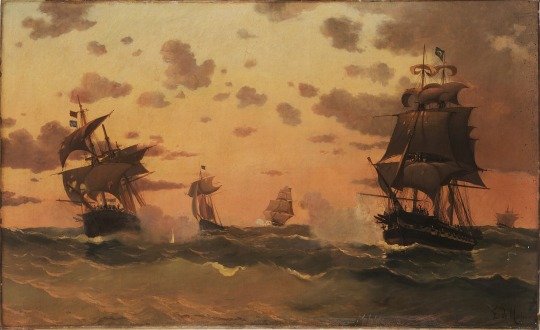
Surrender of the General Dorrego Corvette by Edoardo de Martino
#edoardo de martino#eduardo de martino#art#age of sail#marine art#naval battle#brazil#argentina#brazilian#argentine#imperial#navy#south america#history#empire of brazil#imperial brazilian navy#armada imperial#cisplatine war#cisplatin war#general dorrego#la bertioga#rio da prata#ships#ship#naval warfare#naval battles#south american#sea#waves#royal navy
75 notes
·
View notes
Text

Pair of matching polychromed scrimshawed teeth from whales, depicting two naval battles, around 1840
79 notes
·
View notes
Text
One of the largest conflicts in naval history, the Battle of Lake Poyang forever changed the course of medieval China. This monumental clash in 1363 AD, amidst the scenic expanse of Lake Poyang marked a pivotal moment in the rise of the Ming Dynasty.
This strategic battle unfolded against the backdrop of the Red Turban Rebellion, where former Buddhist monk Zhu Yuanzhang rose to challenge the Mongol-based Yuan Dynasty's rule. Amidst shifting alliances and power struggles, the battle unfolded as a clash of naval supremacy in the Yangtze River Basin when hundreds—if not thousands—of warships maneuvered amidst a storm of arrows and cannon fire. This epic clash has been remembered for the innovative tactics employed. From fire vessels to formidable tower ships, this was a testing ground for naval weapons which yielding devastating effects.
12 notes
·
View notes
Text

Privateers and Gentlemen RPG (1983 Fantasy Games Unlimited) on DTRPG $10usd (affiliated)
Wikipedia: https://en.wikipedia.org/wiki/Privateers_and_Gentlemen
7 notes
·
View notes
Text
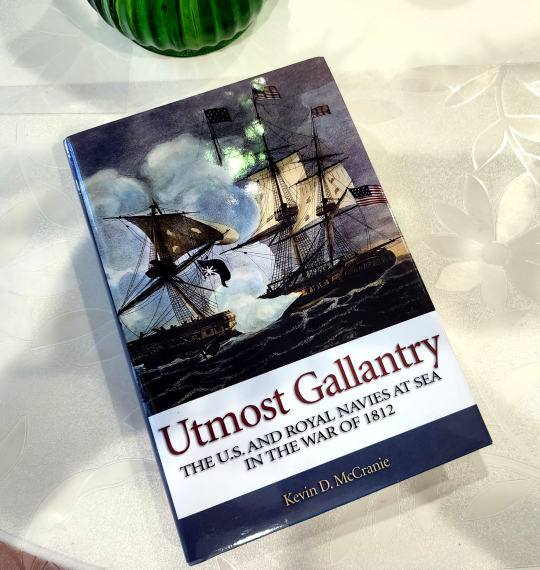
New boat book acquired! Utmost Gallantry: The U.S. and Royal Navies at Sea in the War of 1812, by Kevin D. McCranie. The writer is a historian and professor of strategy and policy at the Naval War College in Newport, Rhode Island, but the book is said to be very even-handed and not biased.
#war of 1812#books#age of sail#military history#royal navy#us navy#naval battles#the sea#utmost gallantry#unfortunately i have little time to read it#but skimming it looks good
13 notes
·
View notes
Text
Battle of Crete :: George Forty
Battle of Crete :: George Forty
Battle of Crete :: George Forty soon to be presented for sale on the fabulous BookLovers of Bath web site!
Hersham: Ian Allan, 2001, Hardback in dust wrapper.
Includes: Plans of battle; Black & white photographs; Chronological tables (1); Maps; Glossary; 2-column text; Appendices (3);
From the cover: Following the successful German invasion of the Balkans and the capture of mainland Greece, the…

View On WordPress
#0-7110-2758-7#1939 1945 war#aerial actions#aeroplane#air force#aircraft#books by george forty#campaigns greece#crete campaigns#first edition books#german crete operations#greek campaigns#heraklion#history greece#hms kashmir#hms kelly#military history#naval battles#naval history#operation merkur#royal navy#scarpanto airfield#stukas#suda bay#world war
0 notes
Text

Officers of Royal Navy submarine HMS Ursula with "Peter" a dog the crew rescued from an abandoned Vichy ship. February, 1943
282 notes
·
View notes
Text
Wet Beast Wednesday: remoras
Sometimes you just want to go with the flow and let someone else do the work. That's the mindset of a remora, this week's topic. Remoras are eight species of the family Echeneidae, divided into three genera. These fish are famous for suctioning onto a larger animal and going for a ride.
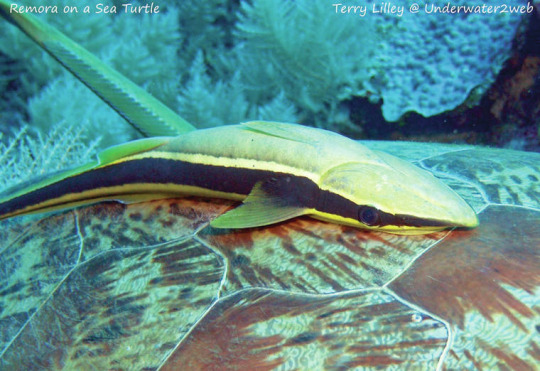
(Image id: a remora attached to the shell of a sea turtle. It is a long, slender fish with a black stripe going down its sides. Its lower jaw is pointed and facing upwards. End id)
Remoras differ in size depending on species, with the largest reaching 110 cm (43 in) in length. Their most famous feature is the disc on their backs. This disc is a heavily modified dorsal fin that consists of flexible membranes. When pressing the disc up against a surface, the membranes can be flexed to create a vacuum and provide suction in a similar manner to a suction cup. The Remora can then scoot backwards to increase suction or swim forward to release the suction and detach from its host. Remoras also lack a swim bladder, forcing them to actively swim to maintain their position on the water column. Fortunately, remoras don't really need swim bladders where they're going. While they can swim and survive on their own, remoras prefer to attach to a larger animal like a bigger fish, shark, ray, or cetacean. When there is a close interaction between two organisms it's called symbiosis. There are three types of symbiosis: mutualism (both benefit), commensalism (one benefits, the other is not positively or negatively affected), and parasitism (one benefits, the other suffers). The relationship between a remora and its host is likely either mutualistic or commensal as the host appears to suffer no downsides.
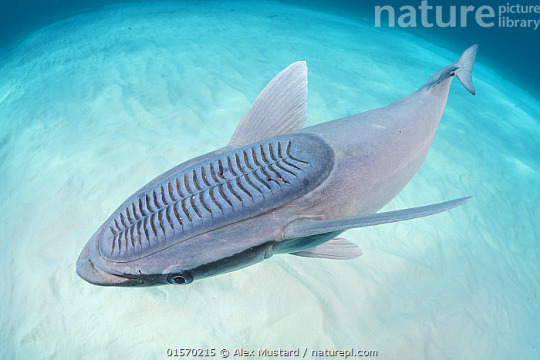
(Image id: a remora seen from above to emphasize its disc. The disc is oval and takes up about 30% of the upper body, starting just behind the mouth. The disc has many rows of darker stripes where the folds are visible)
A remora gets several benefits from being attached to a host. Being in close proximity to a larger animal protects it from predators closer to its own size and gets it a free ride. The ride also helps force air over its gills, keeping the remora well-oxygenated. There are two main methods fish use to keep water flowing over their gills. Ram ventilation occurs when a fish is swimming and their motion through the water forced the water over the gills. Active ventilation requires the fish to actively move water over its gills, often by repeatedly opening and closing its mouth. Both methods require the fish to expend energy, but tests on remoras determined that active ventilation is more energy intensive than ram ventilation. A remora on a fast-moving host can get the best option, using ram ventilation while letting someone else expend the energy of moving forward. Multiple remoras can live on a large enough host and it is speculated that sometimes mated pairs will share a host. It was previously believed that remoras would feed on scraps of food from the hosts meals, but it is now known that they derive most of their nutrition by eating the hosts feces. They also consume bits of dead skin and parasites from the host, which is a lot less gross. This cleaning of skin and parasites is why remora relationships with their hosts are considered mutualistic rather than commensal. There have been reports of hosts attempting to dislodge their remoras through methods such as breaching, so its possible there are situations where the relationship is unfavorable to the host, such as too many remoras attaching. While remoras are very streamlines, too many of them would produce drag, which would be a bad thing for the host.
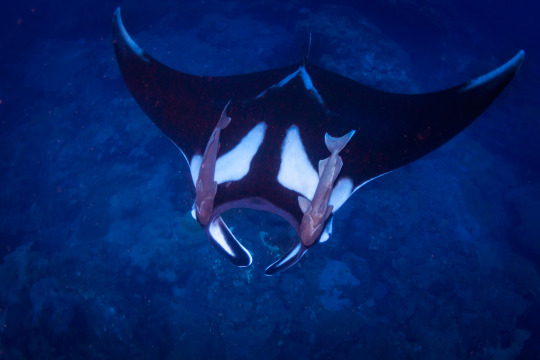
(Image id: a manta ray or similar species seen from above , with two remoras attached to it just behind the cephalic fins. End id)
While remoras are most famous for attaching to a host, they are capable of living on their own. Juveniles are known to live in shallow coastal or reef areas, sometimes acting as cleaner fish. As adults, they move out into the deeper waters, in search of hosts. Most knowledge of remoras come from their behavior when attached to a host, so there isn't a lot we know about how they behave on their own. They are believed to have different diets, being more active hunters who feed on small crustaceans, squid, and fish. We don't know a lot about non-attached remoras, but we know even less about their reproduction. While remoras attached to the same host might become mated pairs, their mating season, mating habits, and what happens to their offspring is not known. All we know is that eventually juvenile remoras will turn up in coastal areas, but what happens between then and spawning is a mystery.
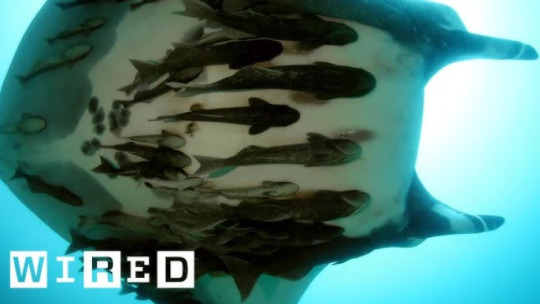
(Image id: a manta ray seen from below with many remoras attached to it. End id)
Remoras popped up in roman folklore as the echeneis, a small fish that could attach to boats and slow them down. Pliny the Elder blamed the echeneis for Mark Antony's loss in the battle of Actium, where poor maneuverability was one factor in his loss. A use for remoras has been in fishing, where a remora is caught, has a line tied to it, and then released. When the remora attaches to a host, the angler can pull in the line, pulling the larger animal in with the remora. The IUCN classifies all species of remora as least concern, except for one, which is data deficient. The largest threat to remoras seems to be threats to their hosts, so conservation of hosts like sharks, whales, and sea turtles will help conserve remoras by default.
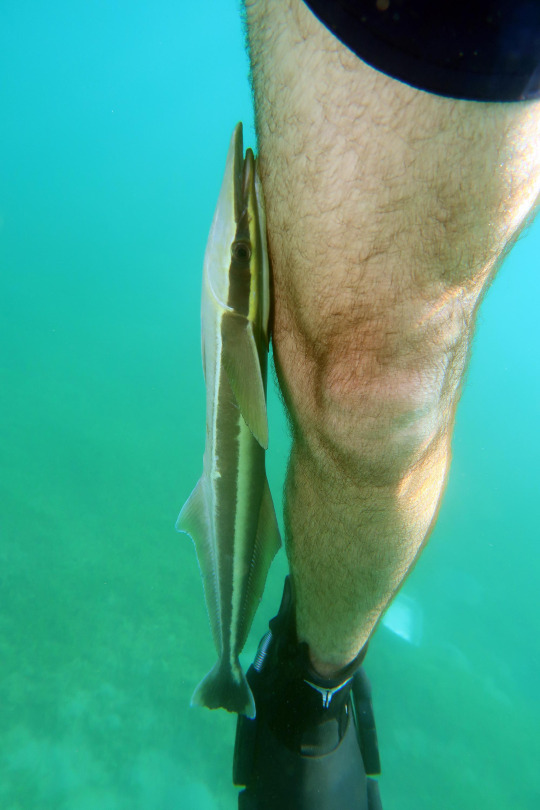
(Image id: a remora that attached itself to a diver's leg. End id)
This was a shorter and less intensive WBW than most of my posts. What can I say, I felt lazy and decided to put in little effort, instead coasting on larger, more successful posts. If only there was an animal I could use as a metaphor for this situation. Can't think of anything, though.
#wet beast wednesday#i had to research roman naval battles for this post about fish#remora#suckerfish#shark sucker#fish#fishblr#fishposting#marine biology#biology#ecology#zoology#animal facts
384 notes
·
View notes
Text
So if Colin Robinson gets drained when people are interested in what he says, does that mean he knew about Laszlo liking his talks about 19th century naval battles and didn't mind getting drained/not getting any energy out of him?
If so, that's so god damn sweet.
#might be reading too much into this#i don't talk about wwdits on social media much#but damn this episode was wild so i had to#colin robinson#laszlo cravensworth#wwdits spoilers#wwdits#what we do in the shadows#wwdits colin robinson#wwdits laszlo#(i'm referencing the colin's promotion ep on the naval battle thing btw if anybody wants to know)
622 notes
·
View notes
Text

The Battle of the Nile, 1 August 1798
by Eduardo de Martino
#eduardo de martino#art#battle of the nile#horatio nelson#age of sail#mediterranean#egypt#france#england#aboukir bay#royal navy#great britain#britain#history#french revolutionary wars#ships#fleet#naval battle#naval battles#french#english#british#naval warfare#napoleonic#warship#warships
240 notes
·
View notes
Photo

Two Meissen Porcelain Vases with Naval Battle Scenes, by Ignaz Preissler (1676-1741) Germany, manufactured ca. 1713–20; decorated ca. 1720–25
128 notes
·
View notes
Text
In Rome’s mock naval battles, gladiators and prisoners fought to the death aboard replica warships, recreating violent sea battles for thousands of bloodthirsty spectators.
21 notes
·
View notes
Text
"Kill them with kindness." WRONG. Prepare for boarding!

#kill them with kindness#is this anything#age of sail#naval history#boarding#naval battle#nelson boarding the san josef at the battle of cape st vincent
378 notes
·
View notes
Text
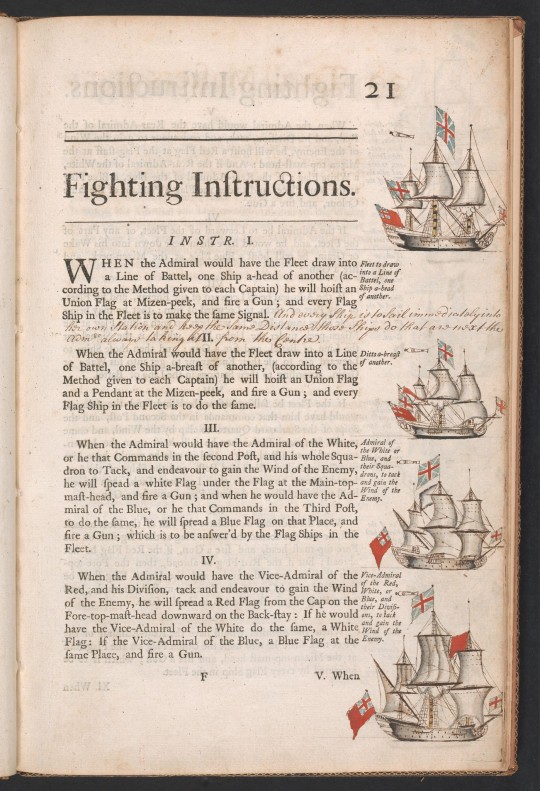
Sailing and fighting instructions for His Majesty's fleet, c. 1711, Yale Center for British Art.
#age of sail#royal navy#18th century#1710s#admiralty#naval battles#manual#military history#naval history
22 notes
·
View notes
Text
I was only today years old when I realized that Trafalgar Law's names are probably references to two battles that led in our real life history to a certain emperor (Napoleon)'s defeat.
*arrives 10 years late with a meta post because of a realization*
uhh Dressrosa spoilers, I guess.
Trafalgar and Waterloo... Water Law.

In One Piece world that emperor being Doflamingo, who suffered two major loses thanks to Law's existence:
First being cca 13 years ago from the main storyline - at the Minion Island where Corazon managed to get the Op-op devil fruit for Law and saving his life from Doflamingo. On that island, Doflamingo lost both Corazon and the devil fruit he wanted to much to get his hands on, as well as Law, someone who he wanted to use as the sacrifice to get the immortality via the devil fruit's powers.
Tbh I haven't really heard about the Trafalgar battle before today. When I first heard about Trafalgar Law as character while I started to read One Piece only cca 5 months ago, I only thought "huh, isn't that a square in England, I was there on a trip once" but didn't look more into it now.
So I just skimmed throught the wiki pages of those battles, I don't know all the details, I don't want to compare it too much, but some maybe similarities/parallels that piqued my interest:
The Battle of Trafalgar were the spanish-france forces against english navy, and Donquixote/Dressrosa arc including all those spanish themes, as well as Law being from the North Blue (where Sanji and Mont Blanc Noland are/were also from) being a bit influenced by France, plays interesting role when this happened in North Blue as a prelude to what would 13 years later happen in Dressrosa (the birdcage, Doflamingo's rule, the puppets, etc).
This part of the Trafalgar battle describing the british was at first outnumbered, that the spanish had more ships along with one of their biggest one:

reminded me of how Corazon himself faced with the whole Donquixote family, including Doflamingo:

and some more interesting similarities how the "hero" of the battle died even before it ended:



but thanks to his informations, the Navy later arrived, and Law got away.

(even on the wiki of the Trafalgar battle there were mentions of some false informations, previous pursuits of the ships and admirals etc, so that vibe kind of fits.)
I haven't read much about the Waterloo battle, except how known it is for being the final defeat of Napoleon, by Coalition armies - which would nicely parallel to Law and Luffy starting their own Alliance during Dressrosa, and thanks to that it caused for Luffy to be there to beat Doflamingo once and for all.


Some other small details I noticed:
The Don Quixote book was apparently first published in two parts, one in 1605 and the other in 1615.
The battle of Trafalgar happened in 1805, and the battle of Waterloo in 1815.
I found one person even connecting the date when was published the chapter of Doflamingo's deafeat in Dressrosa - 18th of June, 2015, which is the same date only 200 years later after Napoleon's defeat at Waterloo.
I love that in some sense both battles have in common water, and for the One Piece world that is connected with pirates and ships - with the historical aspects the battle of Trafalgar being a naval battle, and Waterloo for the Water in Trafalgar D. Water Law - he concealed his full name from Doflamingo for all those years, his secret name as well as the will of the Ds. - for our world a possible reference if one looks more that he really was meant to be Doflamingo's downfall.
There's just something beautiful about Law's whole existence to be a sort of a foretelling of the fall of one of the emperors of the sea, just by having these names. And it's not just the names of his, but the parallels to the situations and results of the incidents taking place at those locations.
It's literally a middle finger to Doflamingo:

#anyway.. i had some law feels bc of this#trafalgar law#trafalgar d water law#one piece#donquixote rosinante#donquixote doflamingo#donquixote corazon#one piece meta#gif:op meta#mine#long post#there could be so much more said about this connection to how law saved luffy and luffy in turned saved him.#how law carries Corazon in his heart as someone that needs to be remembered#how small doflamingo was told that because of his lineage and haki he's meant to be the king of all seas#this was all bc of a book i wanted to start rereading that has nothing to do with one piece. but the first sentence was a setting opening#'93 years after trafalgar' and just that made me remembered oh! naval battle on the seas with the same name as a beloved character!#now i can hopefully go back to start rereading that book lol
88 notes
·
View notes
Text
MADE WITH LOVE gus doesnt hate the party (most of the time)
#gus when mudd turns into a plesiosaurs and avoids the entire naval battle they planned#tales from the stinky dragon#stinky dragon pod#tftsd#guzzler tftsd#guzzler#gus sorola#artists on tumblr#ALSO THIS IS LITERALLY KILLING ME THIS IS THE FUNNIEST TJING IVE EVER MADE
94 notes
·
View notes